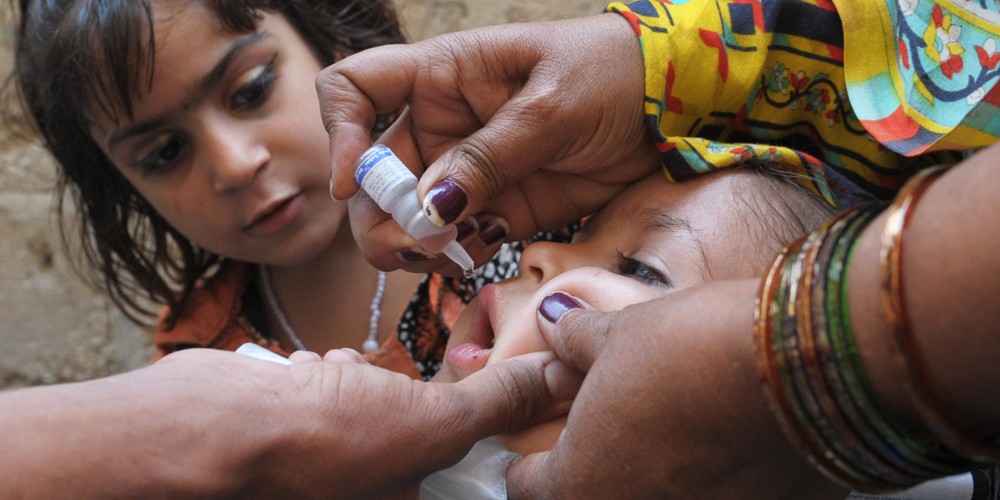
Polio workers in far-flung areas, like villages in Rajanpur district, are trying their best to vaccinate every child

Children gather on the veranda of a house in the remote village of Budh Azam, some 40 kilometres from the main city, Rajanpur watching a local polio worker administering vaccine drops to a little Alishba.
"In the name of God, the curer," Rafia Bukhari whispers gently after releasing two drops from the vial into Alishba’s mouth.
"We’ve had to wait a long time to vaccinate this adorable girl," smiles Rafia, who has spent the last six months working as a Union Council Communication Support Officer in the village.
"Alishba was not vaccinated during the first four days of campaign so we were worried. Her family had gone to visit relatives in a nearby village. We kept a track of her and made sure that she is not missed during this campaign."
Rafia is perspiring heavily in the hot desert village of South Punjab, where temperatures regularly hit 50 degrees Celsius.
Thousands of children are believed to have gone unvaccinated in the province during each round of vaccination because they are not at home when the polio workers call, having either travelled to see relatives or accompanying their mothers to the fields to harvest crops. Children who routinely miss vaccinations are more vulnerable to the debilitating disease since their immunity level is compromised.
Tracking and vaccinating these children poses both the biggest priority and challenge for the polio teams in Punjab, as well as to social mobilisers. Just two drops of the vaccine can safeguard against permanent paralysis.
Although just below 1 per cent of all children under the age of five go unvaccinated, the numbers are significantly high. Polio workers have to travel by foot on a daily basis to reach children whose homes are located in the centre of villages, which are typically inaccessible by road.
Rafia is one of a handful of polio officers working in Punjab’s high-risk union councils. "To go out and help children secure a healthy future is something I cherish", she says. She explains that at the end of every campaign, polio teams compile a list of unvaccinated children. It is then up to Rafia to locate them and coordinate with the team once the child is available for a home visit.
"In the beginning, I was lost in a maze of cotton, wheat fields and mango orchards," Rafia recalls, adding that it was not long before families understood the drops were for their children’s own good. "I approach local imams for help, since they are able to positively influence their communities. They use the mosque’s loudspeakers to make announcements, requesting parents to stay put during the campaign until all the children are vaccinated," the health worker notes. "These announcements help us a great deal."
In Rajanpur, up to 30,000 children on average are typically marked unaccounted for during the first three days of a polio campaign. Health workers like Rafia have just 10 days to track them down and vaccinate them.
It is not just the non-administration of polio drops that poses health risks for children under five. When combined with below average vaccination coverage for all other antigens -- the threat is grave.
Children who fail to receive the first round of Oral Polio Vaccine and BCG antigens, both of which are crucial for all new-borns to protect them against polio and tuberculosis, are identified as ‘zero dose’.
It is critical to ensure that children complete full courses of routine vaccines so that they are permanently immunised against diphtheria, pertussis, measles and childhood influenza.
Health workers like Rafia go beyond their traditional role of polio eradication to ensure children are vaccinated against all other preventable diseases. "I maintain the list of children who are recently born and hand it over to the vaccinator. Since union council health facilities are located a long way off villages, we liaise with local community members and select places convenient to the majority of mothers," Rafia explains.
"Then we go door-to-door and inform the parents about the vaccination dates and venue."
Director of the Expanded Programme on Immunisation, Dr Munir Ahmad, is all praise for frontline health workers and acknowledges their contribution. "It’s very difficult for health workers to vaccinate every single child, especially if you take into account the vast area and number of children, terrain and hot weather. That’s why we place special emphasis on maintaining lists of unvaccinated children."
According to Dr Munir, "The programme has improved efficiency in terms of follow-up of unvaccinated children through including these children in the next campaign’s micro-plan schedule."
"Punjab has registered a marked improvement in Routine Immunisation coverage over the last year. Immunisation coverage in ten randomly picked districts was put at above 90 per cent. But we still have weak districts where immediate improvement is needed," says Dr Munir.
He says in southern districts such as Rajanpur the coverage was around 50 per cent as per different surveys, much behind our overall average in the rest of Punjab."
In order to reverse this, Dr Munir says that polio eradication initiatives are being employed in the area. Besides increasing the accountability of government staff, we are also working with international development partners for out-of-the-box solutions."
"When I joined, everybody in my family was against it. They thought it would be difficult for a young woman like me to go to villages and hold discussions with families," says Rafia.
"Taking care of the children in her community was something worth fighting for. There was no looking back after that," she says.